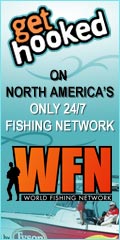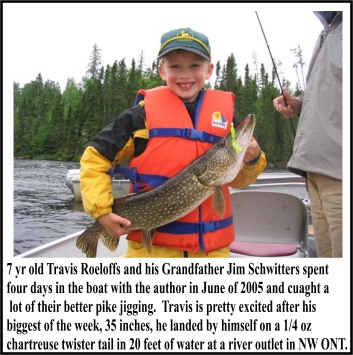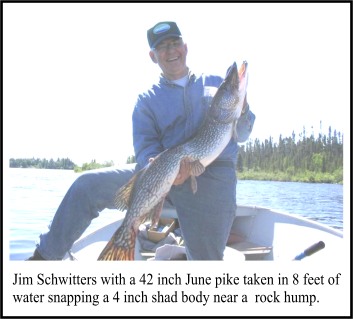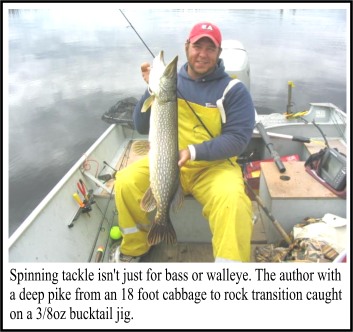
Click Here
|
"Jigging Early
Summer Pike"
By J.P. Bushey
 Yes,
my pike box is full of the same large jerkbaits, big thumper spoons
and wild looking spinnerbaits as yours probably is. And yes, hitting
a big pike casting one of these classic lures is a rush when it
happens. (If nothing else, it sure helps in justifying the money
spent on them or the two hundred pound tackle bag they live in.) But
bigger fish are in and out of shallower casting depths faster than
most fishermen realize, and one of the best lures to catch them on a
consistent basis is also the cheapest: the jig! It has no equal when
it comes to staying in a pike's wheelhouse after the spawn, and the
fish eat them no matter where they are or what mood they're in.
They're as universal as lures get. Yes,
my pike box is full of the same large jerkbaits, big thumper spoons
and wild looking spinnerbaits as yours probably is. And yes, hitting
a big pike casting one of these classic lures is a rush when it
happens. (If nothing else, it sure helps in justifying the money
spent on them or the two hundred pound tackle bag they live in.) But
bigger fish are in and out of shallower casting depths faster than
most fishermen realize, and one of the best lures to catch them on a
consistent basis is also the cheapest: the jig! It has no equal when
it comes to staying in a pike's wheelhouse after the spawn, and the
fish eat them no matter where they are or what mood they're in.
They're as universal as lures get.
The size of the pike's home range in Ontario is pretty amazing when
you stop and think about it. From downtown to mining towns, and all
points in between, these fish live in a huge variety of water-types.
Jigs work in early summer everywhere. Deep, cold lakes, lakes that
bloom with algae in farm country, tea-coloured lakes, all over the
Shield and in all the rivers. 'Umbrella'type thinking can be
dangerous to a fisherman: trying to gather pods of information and
then jam them into your localized conditions where they might not
fit can lead you off track. But jigs, June and big pike are as close
to the silver bullet as it gets. You will be able to catch bigger
fish and more of them if you learn to fish jigs.
When pike start to roam and eat normally in early summer, they've
got a lot of feeding options, and there are two ways you can
approach this fact. The popular answer is to try and do it all, and
to do it all big, loud and fast for fish that obviously have food on
the brain and lots of it to choose from. After all, it's been a long
winter for fishermen, too. Whipping around your new spoon or
jerkbait can be awfully tempting, and this can certainly put you
onto big fish when things all fall into place. The other approach,
and the one that I've found more reliable, is to accept the fact
that pike have a lot of feed at their disposal on classic spots but
they still might not need to work that hard to eat. Forage might be
perch, walleyes or suckers in one lake, or it could be trout and
herring in another. The best fish will be close to the best food.
For well-fed fish hanging around forage, the jig fits in a lot of
ways.
You can't skim a magazine article about pike fishing at this time of
year that doesn't talk water temperature, and this is because it
really dictates where big pike can and will live. Pike really are
more like lake trout than they are muskies in this regard. So the
water's warming up and the forage is blooming in depths pike like to
live. You can work a spoon, spinnerbait or sinking plug like a
Rattle Trap at these levels but not as consistently as you can a
leadhead jig.
 Are
they the most efficient way to cover water? Probably not. But if you
measure efficiency by quality fish landed as a result of quality
time spent at the right depth, jigs take on a new look. On the right
tackle and with good boat control, you can actually cover a lot of
water jigging, with your lure in the strike zone the entire time.
Deep trolling is the only thing that comes close (jigs are also
great trolling lures). Because of their huge habitat and geographic
home range, making generalizations about the best pike depths is
impossible. But whether you're in eight feet of water on Lake Of The
Woods or in twenty eight feet an hour outside Toronto, you can pick
a jig and work it. It's all the same. You can fish them vertically
over smaller pieces of structure right under the boat or move along
deeper contours and edges back trolling or using any combination of
the wind, your electric motor or a drift sock. Are
they the most efficient way to cover water? Probably not. But if you
measure efficiency by quality fish landed as a result of quality
time spent at the right depth, jigs take on a new look. On the right
tackle and with good boat control, you can actually cover a lot of
water jigging, with your lure in the strike zone the entire time.
Deep trolling is the only thing that comes close (jigs are also
great trolling lures). Because of their huge habitat and geographic
home range, making generalizations about the best pike depths is
impossible. But whether you're in eight feet of water on Lake Of The
Woods or in twenty eight feet an hour outside Toronto, you can pick
a jig and work it. It's all the same. You can fish them vertically
over smaller pieces of structure right under the boat or move along
deeper contours and edges back trolling or using any combination of
the wind, your electric motor or a drift sock.
In water where there are good numbers of walleyes, finding big pike
in June usually means finding them first. River mouths or places
with current where walleyes travel or linger around long after
spawning are worth checking. Any bars, shoals or budding weed edges
in these areas are usually the prime locations. Soft bottom flats
and bays with patchy weed, wood, perch and bug larvae can be amazing
when it's been really hot and the hatches are ready to explode. They
seem less productive after late springs or when cold, miserable
weather has slowed the food chain down. You've probably heard that
the biggest pike take over the best spots on the best structures, or
something to that effect. It's absolutely the truth. In these
situations, I simply rig up for walleye! You could have life a lot
rougher than putting up with these fish sucking back jigs while you
wait for one of those railroad ties to come a long. Same classic 'thunk'
on the jig, except you set the hook and that split second feels like
an hour. Then it's just dead, heavy pressure. The most efficient and
sporting set-up I've found in these situations day in and day out is
a medium action spinning outfit with ten pound monofilament or
no-stretch line and twister tails from three to five inches long.
I've used light, Sevenstrand wire rig to the jighead with no
hardware for years, but have started experimenting with fluorocarbon
from 23 to 33 pound test and like it, so far.
You might be fishing from an anchored position and fan-casting,
drifting or slowly creeping along with an electric motor keeping
your jig right under the transducer cone. Whenever walleyes move
into an area, expect pike to be either right behind them or waiting
on the prime features. I've caught some of my biggest fish in June
right when the bugs are getting bad in the evening, or within the
first two hours of daylight. Pay attention to the condition of any
walleyes you jig up. Freshly mauled ones are common when you're in
the right areas. Jig weights on these spots are totally
case-specific, carry them from 1/8 to 1 ounce. Ballheads are the
best for fishing vertically, jigs with the line-tie closer to the
nose and at more of an angle work better for dragging or casting.
Wedge, stand-up, bullet or the flattened, 'swimming' style all work.
Jigs are dirt cheap. You're going to lose a lot, so buy a lot. In
the walleye lakes, orange, chartreuse, yellow and white are all
good. Scented twisters or tipping with live or dead bait can all
make a difference some trips. This program has really worked well
for me in the tea-stained Shield lakes and rivers, where most guys
are after walleyes first and the pike are an afterthought or even a
nuisance. Current is often a factor. Pike love eddies and also use a
variety of current breaking features either along the bottom or
extending out from shore. Keep this in mind when you're picking your
jig weights and fishing line.
 Weeds
can be hot in June when the weather and water has been right and
they've had a chance to begin growing and acting as nurseries for
small fish and insects. Don't forget that good stands of weeds never
die in some spots, and stay full and thick all winter under the ice.
Deep to mid-depth patches of cabbage or coontail over soft or firm
bottom are like factories year-round. In the new weeds that grow
shallower, focus on the deeper edges. Even though they may be
sparser, they'll still produce, pike will skirt them as they roam.
In shallower spots, inside turns or areas where weeds meet large
rocks or incoming/exiting current are also very key. Remember that
big pike take the best spots. Some of my best spots are ones where I
can visually see the gap in the rocks plugged with weed, pitch an
easy cast in and yet still have my sonar reading twenty or even
thirty feet deep. Weeds
can be hot in June when the weather and water has been right and
they've had a chance to begin growing and acting as nurseries for
small fish and insects. Don't forget that good stands of weeds never
die in some spots, and stay full and thick all winter under the ice.
Deep to mid-depth patches of cabbage or coontail over soft or firm
bottom are like factories year-round. In the new weeds that grow
shallower, focus on the deeper edges. Even though they may be
sparser, they'll still produce, pike will skirt them as they roam.
In shallower spots, inside turns or areas where weeds meet large
rocks or incoming/exiting current are also very key. Remember that
big pike take the best spots. Some of my best spots are ones where I
can visually see the gap in the rocks plugged with weed, pitch an
easy cast in and yet still have my sonar reading twenty or even
thirty feet deep.
Bucktail jigs are great in weeds, and pike love them. Make shorter
casts, and wait for the bow in your line to fall flat before you
move your rod. Reel down to the jig and explode it upwards or
slightly to the side. Let it settle, watching your line, and pause
again. Continue this all the way back to the boat. Just because pike
are using weeds for feeding sessions doesn't mean they're burried
directly in them. Pike are a classic edge-traveller, and they're
just as likely to be on the doorstep of prime weed spots as inside,
laying on the sofa. If there are weeds up in the pike lakes I'm
fishing in June, you could leave me alone all weekend with a 3/8
ounce white or chartreuse bucktail jig and I'd be set. Flipping jigs
like you'd use for largemouths are another excellent bait. Northland
makes a really ingenious jig called the Jungle Jig that has loud,
free-swinging rattles on short pieces of Dacron line strung within
the skirt material. They don't interfere with plastic or natural
trailers threaded onto the hook shank, and they're really loud. The
line-tie is recessed and it has a good hook. I like heavier jigs
even on weed spots as shallow as twelve or fifteen feet, so that the
lure explodes and lands sharply and stays deep all the way back to
the boat. Ask a tournament bass fishermen how many big pike he's
been bitten off by or landed on weed edges in early season events,
on a jig 'n pig. Later into summer and fall, I use bucktails and
flippin jigs on the rock spots down past twenty five feet. I throw
most of my hair jigs on medium heavy spinning gear with 50 to 65
pound braided line, and use the same weights on regular flipping
rods for baits like the Jungle Jig.
In deep, all-season weeds on the oligotrophic lakes, you're already
one step ahead if you've located spots that have deep weed year
after year. Weeds can be scarce on this type of water, and big,
healthy patches are natural magnets. Depending on how deep they are
(I have weeds in 22 to 25 feet on some lakes) and the size of the
bed, you might drift and jig semi-vertically or cast and retrieve.
Wind is usually the deciding factor no matter what the spot's
make-up is. In deep or windy conditions, Lunker City's wedge head in
½ to 1 ounce with a five-inch shad body or Reaper tail is probably
my favorite. I carry this combo in my boat for muskies and pike all
year. Berkley's Inshore Series Power Grubs or Kalin's Mogombo are
two excellent trailers also. White is my favorite colour, but
there's no reason why other colours wouldn't work also. Smelts,
suckers, trout and herring are all light-coloured in this type of
water and white is all I use because it works for me and I have
confidence in it. I'm always amazed at how these big fish won't
chase even the slowest spoon or crankbait but will eat the jig.
Rock-soft bottom transition areas on the deep, clear lakes are great
early in the summer, and all year. Some of these spots can be very
large, and drifting a heavy, soft plastic jig on and off the break
is a trophy technique. Wherever and whenever you mark an
irregularity along the deep transitions, re-work the area either by
hooking back around immediately, or tossing a buoy and running back
after the run is done. Pike will suspend in these situations too,
and the thermocline doesn't have to be set for them to hunt higher
in the water. Experiment whenever your sonar is showing you activity
well off the bottom by jumping that jig several feet, reeling up
several feet, snapping it again, and then bombing it back down.
Transition areas in the twenty to forty foot range can have
schooling whitefish, walleyes and suckers feeding along them in
early summer, with new crops of bug larvae emerging as the water
gradually climbs the ladder towards summer peak. The prime food is
there, and pike just seem to like a dopey jig that's easy to
overtake without much effort. Remember on the more sterile,
oligotrophic pike lakes, re-visiting the cherry spots again and
again is what it takes. They're fewer and further between than on
more fertile lakes, and big fish will show up on them almost out of
necessity. They take on heightened importance.
Even heavy jigs in current on the walleye lakes or on deeper
structure on the trout lakes fish surprisingly trouble-free. They
let you stay close to vertical, and you'll walk over snags better
than you would using a light jig with lots of line out and a lower
angle. On braided line, you'll feel them bang down on the bottom
after every lift or after you've casted them out. Pike feel this
with their lateral lines, too. In wood or weeds, pay extra attention
to jig weight, it's amazing how the right jig will stay on your line
rather than being broken off. Having a good selection, and making
the small adjustments can be what makes or breaks a trip.
Where current, cover and wind allows, you can stay around big pike
with a jig and still comb through a lot of water. On the
spot-on-the-spot, no lure beats a jig for precision, learning what
type of bottom is under your boat and for winning over a fat,
sulking sow. Jerkbaits, spoons and other lures all have their days,
but it just seems like the jig bite never dries up. When the big
pike are long gone from shallow water, you can catch 'em on jigs
wherever they're hanging out. You can play it fast and aggressive if
you need to, or slow it down and blow other lures presentations out
of the water. Pike have a special affinity for jigs, as do all fish
at one time or another. It's a quality technique that can start your
summer off with a bang.
|